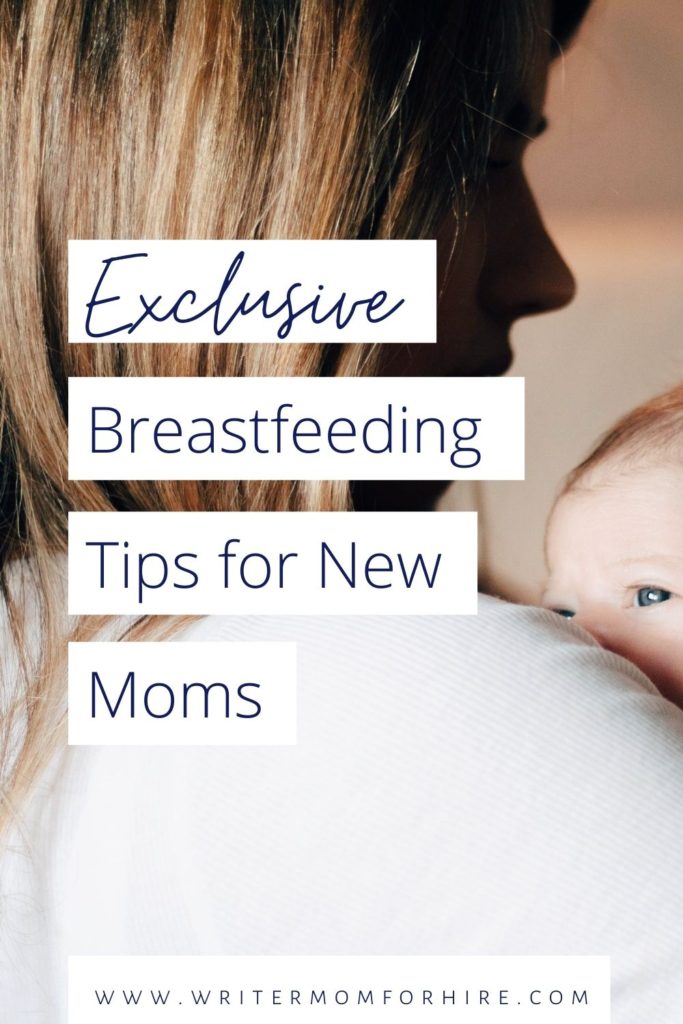21 Breastfeeding Tips for First Time Moms Who Want to Exclusively Nurse
This post may contain affiliate links and we may earn commissions when you make a purchase through these links (at no extra cost to you). See our disclosure policy for more details.
Breastfeeding for the First Time: Tips and Tricks to Help You Succeed
If you have a newborn, or if you’re going to have one in the near future, and you want to exclusively nurse your precious little bundle, then you’ll want to read these exclusive breastfeeding tips for first time moms.
Breastfeeding may be “natural”, but it’s HARD work! (You can trust me on this — I’ve been doing it for more than four years straight, and it’s not always a walk in the park!)
But we as humans have been doing it forever, so you should know that YOU CAN DO IT. And it’s totally worth it if you choose to push through.
I understand that some are unable to find success with breastfeeding for various reasons, but the majority of us CAN if we are able to work through the challenges.
This is for those of you who are breastfeeding for the first time and want some tips to help you start out strong.
(Don’t worry, there will be some tips and information for getting through the challenging times, as well. )
Let’s jump right in!

I am not a medical professional, and this information is not intended to replace medical advice.
1. Initiate breastfeeding within the first hour.
Ideally, you’ll be able to share some skin-to-skin time with your newborn immediately after giving birth.
And, oftentimes during this skin-to-skin, newborns will do the “breast crawl” to breastfeed for the very first time.
Seriously, how cool is that?!
They can actually wriggle their way to the breast and root around, trying to latch. Both of my girls attempted it after they were born, although we were so sticky with sweat that they needed a little help.
My second daughter had a really strong latch, and she nursed for an hour and a half straight that first time!
The benefits of breastfeeding within the first hour include (source):
- prolonged duration of breastfeeding
- improved lactation and less loss of blood
- reduction of infant mortality
- stimulation of the hormones that make milk
So if you are hoping to exclusively nurse your newborn, you’ll definitely want to initiate breastfeeding as soon as possible after birth (ideally within the first hour).
2. Follow your baby’s cues.
People like to give all kinds of advice when it comes to feeding your baby, but ultimately, you know your baby best. You’ll learn her cues over time.
If your baby is hungry, feed her! Yes, it IS okay to breastfeed on demand rather than following whatever schedule someone *told* you to follow.
Breastfed babies nurse for a number of reasons, in addition to hunger, and they are really good at taking in the right amount of milk to fill their bellies.
When your baby is content, you’ll notice that her hands go from clenched to relaxed. When done nursing, she’ll typically either fall asleep or unlatch.
You should offer the other breast, and she’ll either take it if still hungry or refuse it if she’s done.
And if she’s full but continues nursing for comfort, she will often unlatch as soon as your milk lets down again. Just follow your baby’s cues, and you’ll do fine.
Related: Help! My Baby Squirms While Breastfeeding
3. Lots of skin-to-skin!
People typically think of skin-to-skin, or “kangaroo care”, in the first few hours after birth.
But it doesn’t have to end there!
Practice lots of skin-to-skin time in the days, and even weeks, after your baby is born to help establish a nursing relationship, and to help increase the odds of having a successful breastfeeding journey.
Practice lots of skin-to-skin time in the days, and even weeks, after your baby is born to help establish a nursing relationship, and to help increase the odds of having a successful breastfeeding journey.Click To Tweet4. Try different positions to figure out what works for you.
No, you actually don’t have to hold your baby in the cradle hold for every feed!
Got a fast letdown that chokes your baby? Try laid-back breastfeeding in a recliner or in bed with pillows propping you up slightly.
Master safe “breastsleeping” in the side-lying position.
Try different positions to figure out what works best for you — and switch it up as needed.
5. Set up a nursing station.
You’ll probably find yourself glued to the furniture in the first few weeks having a baby. And, naturally, you’ll find yourself parched and your bottle of water will be nowhere near.
Thankfully, there IS a solution! Set up a nursing station with all the essentials.
You’ll need:
– a comfy chair
– an end table with storage
– a good nursing pillow
– nursing pads
– burp cloths
– snacks
– phone charger
– book, magazine, phone, remote control, etc.
Here’s my ultimate breastfeeding station checklist for new moms — check it out to make sure you have everything you’ll need at an arm’s reach away!
6. Heal cracked nipples with breastmilk.
I can’t believe nobody told me this before having my first baby! For the first couple weeks, nursing was pretty painful, no thanks to cracked nipples.
I honestly thought the only solution was to use lanolin cream.
…how wrong I was!
What is the fastest way to heal sore nipples?
I’ve since learned that the best way to heal cracked nipples is to apply a bit of expressed milk onto them, let them dry, and then (optionally) apply a nipple cream or salve.
Live and learn. Fortunately, it only lasted a couple weeks, and I haven’t had to deal with this problem again.
How do I prepare my nipples for breastfeeding?
You might have heard that you need to “prepare” your nipples by rubbing them. Not true!
Just work on your latch and, if you experience sore or cracked nipples, then use your own milk and some nipple salve to heal them.
7. If it’s painful, unlatch and re-latch your baby.
Things like cracked nipples and blocked milk ducts are painful, no doubt.
But if breastfeeding hurts, it’s likely due to a bad latch. Simply unlatch your baby (by slipping a clean finger into the mouth and breaking the suction) and try again.
If your baby latches onto just the nipple, it’s going to hurt. You’re going to want a deeper latch than that.
A few signs of a good latch:
- baby’s chin is touching your breast and he can easily breathe through his nose
- his mouth is open wide and he is latched onto your areola
- he starts with short, quick sucks before sucking more slowly and deeply
Often, all it takes is unlatching and re-latching, and the pain should go away. If it doesn’t, there could be a different issue, and you might need to seek a professional opinion.
8. You can feed your baby to sleep if you want to.
“Don’t let your baby fall asleep at the breast.” This is one of the first things the hospital “taught” me after my first daughter was born.
News flash: Yes, you CAN feed your baby to sleep if you want.
No, it’s not going to teach your baby “bad habits”. It’s biologically normal for babies to fall asleep at the breast.
Once I figured this out, my life got infinitely easier. In fact, I’m still feeding my almost two-year-old to sleep for every nap and at bedtime.
Not gonna lie, I’m hoping to night wean soon, but feeding my daughters to sleep was waaaay easier than fighting them.

BONUS: You can also safely bedshare and practice “breastsleeping” by following the Safe Sleep 7.
This means:
- You are a nonsmoker.
- You are sober and unimpaired.
- You are a breastfeeding mother .
- Your baby is healthy and full-term.
- Your baby is on his back.
- Your baby is lightly dressed.
- You are both are on a safe surface.
Related: Should I Pump If My Baby Sleeps Through the Night?
9. Clear blocked ducts right away.
What the heck is a blocked duct?
Plugged or blocked milk ducts are caused by plugging, blockage, or poor drainage of a milk duct or section of the breast. It often follows incomplete drainage, skipped feedings, or stress (source).
So, let’s say your baby cluster feeds for a while, then goes a longer period of time without nursing. Well, you might end up with a clogged duct, or an incredibly painful lump in your breast.
Another way to get one is by forgetting which side you fed from last, and then going too long in between feeding on one side.
But regardless of the cause, you want that clogged duct gone — and you want it gone FAST. Because an untreated blocked milk duct could lead to a nasty case of mastitis.
So, what’s a mom to do?
Well, you could pump a whole lot. Or, you could read this article about how to get rid of a clogged milk duct without pumping.
10. Invest in a good quality nursing bra.
The difference between a nursing bra and a regular one? Nursing bras have cups that clip down, fold down, or pull aside for quick (and often one-handed) access.
If you’re hoping to breastfeed for a year or two, you’ll definitely want a comfortable, good quality one. Trust me on this!
Amazon.com and Kindred Bravely are a couple good places to start looking for nursing bras online.
Take the quiz to find your top 3 maternity and nursing bras
11. Save money with cloth nursing pads.
Another thing worth mentioning: While you can use either disposable or reusable nursing pads with your nursing bra, I prefer reusable cloth nursing pads.
They are more comfortable, and they can be washed and reused an unlimited number of times.
12. Drink plenty of water (and eat enough food!).
This isn’t for your baby’s sake so much as for your own.
Because, no matter what you eat and drink, you will still be able to produce nutrient-rich breastmilk for your babe (unless you’re severely malnourished or dehydrated).
But you’ll definitely want to eat plenty of food and drink enough water to provide your body with the energy it needs to keep up with the demands of a newborn and milk production.
Not taking care of yourself can really take a toll on the body, after all.
13. Avoid bottles while establishing breastfeeding.
It’s generally recommended that you wait until your baby is 4-6 weeks old before introducing a bottle. This is to help avoid nipple confusion.
If you plan on exclusively breastfeeding and won’t have to leave your baby at daycare, then you might not have to introduce a bottle at all.
To be honest, neither of my babies accepted a bottle (other than my second daughter when she was younger, and that was still pretty iffy).
Of course, it doesn’t hurt to introduce a bottle just in case something were to come up and you end up having to leave your baby with a caregiver.
But, honestly, from what I’ve seen, a lot of exclusively breastfeeding stay-at-home moms find that it’s really not necessary.
14. Invest in a good, firm nursing pillow.
I wouldn’t even bother with a soft nursing pillow. They have a tendency to slide around.
My Brest Friend is a firmer nursing pillow with a clasp, so you can secure it around your waist. Trust me, it’s not going anywhere!
Plus, it has a handy little pouch so you can keep your phone, a burp cloth, or whatever you might need handy.
You can check out the My Brest Friend nursing pillow right here.
15. Don’t look at the clock.
As they say: Watch your baby, not the clock.
After having my first baby, I was way too obsessed with the frequency and duration of our breastfeeding sessions. After all, from what everyone tells you, your baby should be nursing every X hours for X minutes at a time.
BUUUUT…..
The majority of babies nurse for many reasons: they’re hungry, thirsty, in need of comfort, etc. And that can vary from one session to another.
The majority of babies nurse for many reasons: they're hungry, thirsty, in need of comfort, etc. And that can vary from one session to another.Click To TweetSo whenever the nurse at our clinic asked me how often my daughter nursed and for how long, I tried to come up with an average, but it always felt like a lie.
I probably should have said, “Whenever she wants to…until she decides she’s done.”
Seriously, though, when it comes to breastfeeding, it’s okay to watch your baby — NOT the clock.
16. Count wet and dirty diapers.
Okay, I’m not saying to obsess over the number of diapers you change each day. Not at all!
But if you’re worried that your baby isn’t getting enough breastmilk while exclusively nursing, observing output is one way to keep an eye on things.
Your baby should have plenty of wet diapers throughout the day, and if it doesn’t seem like enough, you can always check with your pediatrician.
Dirty diapers can vary quite a bit in breastfed babies. I have one child who has always gone daily, while the other was a once-a-week baby, and still doesn’t have dirty diapers more than a few times a week.
But if your baby is pooping with some regularity, then you shouldn’t have to worry too much.
17. Feed your baby — not the freezer.
Believe it or not, you actually don’t have to create a huge freezer stash (unless you want to wean early and bottle feed or donate your breast milk).
It doesn’t hurt to have a few bags of milk in the freezer, and you’ll want to pump a little ahead of time if you are sending your kiddo to daycare.
Otherwise, pumping a lot of milk is a waste of time, and only serves to tell your body to continue producing more than is needed to feed your baby.
18. Join a support group.
Whether it’s a local breastfeeding group or a virtual group on social media, every nursing mom needs to have a supportive breastfeeding community for questions that might arise.
And even if you don’t necessarily have questions, it’s always nice to know that there are other parents in a similar situation.
I’ve seen and learned a lot from various like-minded virtual communities, so don’t discount their value!
19. Get professional support.
In addition to having a supportive community of fellow breastfeeding mommas, it’s not a bad idea to have a lactation consultant at hand.
This way, if any issues arise, you’ll already have an established relationship with a professional who can offer guidance and solutions to any obstacles that might arise.
Check out USCLA’s website to find someone near you.
20. Layer your wardrobe for public nursing.
This is one of my favorite breastfeeding tips for first time moms.
While I love the few items of nursing-specific clothes that I own, you don’t HAVE to buy special breastfeeding tops if you don’t want to.
Simply layer a nursing cami under a looser-fitting top, and you’re set. When it’s time for a feed, simply pull the shirt up and the cami down, and your tummy will remain covered (and warm!).
Related: How to Nurse Your Baby in Public Without a Cover
21. Set a breastfeeding goal and reach for it.
Before I had my first baby, I had no idea how long we were going to be breastfeeding. All I knew was that I wanted to try to nurse her, and didn’t really know what to expect.
At first, I hoped to nurse her for at least the first six months, and then my goal was one year.
Joke was on me, though!
She was still nursing once a day at 2 years and 4 months old when her baby sister was born, and I tandem nursed them for 3-4 months before nursing aversion hit hard and I decided it was time to wean her.

At the time of writing this post, I’ve been breastfeeding for the past four years and 3.5 months straight. My toddler is almost two, and there is no. end. in. sight. (Although, fingers crossed, I’m hoping to start night weaning soon!)
My point in sharing this is that you can do it. Set a goal, and reach for it.
How long should a new mother breastfeed?
While WHO recommends breastfeeding for the first two years, the duration of your breastfeeding journey is ultimately up to you and your child.
(And, yes, I realize that some are forced to wean due to various obstacles, but the majority of obstacles CAN be overcome.)
First Time Mom Breastfeeding Essentials
Let’s face it: you really don’t need much to get started with breastfeeding for the first time. That said, there are a few “breastfeeding essentials” that are pretty nice to have:
– nursing bras
– a good nursing pillow
– burp cloths
– nursing cover (if desired)
Breastfeeding Tips for First Time Moms
And that’s a wrap! Twenty-one of the absolute best breastfeeding tips for first time moms that I could come up with.
What’s your favorite tip for moms who want to exclusively nurse?
Related:
What’s a Baby Wrap You Can Nurse In?









Solid list, these tips are so helpful for ensuring a successful breastfeeding journey
Thanks, Cate!
I love all the information you give here! I know breastfeeding is something a lot of new mothers worry about and I can totally see why. These tips really make me feel a little more confident that I could do it right and I’m glad you suggested some helpful products too. New mothers have so much to worry about so this post relieves some of that stress.
Thanks, Heather! It can certainly be nerve-wracking, but hopefully these tips will help new moms gain the confidence they need to successfully breastfeed and work through any issues that might come up.
I can’t believe I’m saying this, but I miss breastfeeding. This is a really helpful list. For me it got easier with each one. Love the advice of not getting overwhelmed by all of the advice and doing what feels right to you and baby.
Agreed! Breastfeeding does get easier with each baby. I know I’ll miss it someday, so I try to enjoy this time with my daughter, even when I’m feeling really touched out.